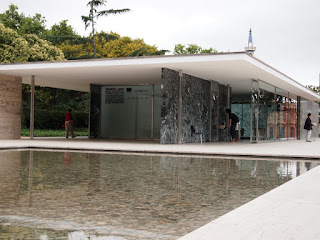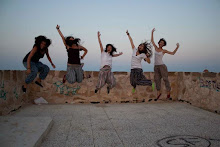Traveling through Europe this summer opened my eyes to graffiti as a form of expression and creativity. Just as architecture affects how people live, street art has the ability to change the way people interact with the built environment and each other. It is a form of communication displayed on buildings and structures that can compliment, deface, or even become architecture.
Within the four countries I explored, there were street art trends of varied scales (e.g. continent-wide, country-wide, city-wide…street-wide). The pieces displayed a message of political, memorial, economic, patriotic and/or artistic value. Even though I saw relationships and could categorize the graffiti I saw, each piece was its own individual work of art that meant something different from all the rest.
Here is my European journey (via graffiti):

Mushroom on facade of Biblioteca Jaume Fuster, Barcelona, Spain. Video game homage in a cul-de-sac where children play soccer.

Taken on the train ride from Barcelona to Alicante.

Illuminati eye and pyramid. Taken from Parque Reina Sofia, Guardamar del Segura, Spain.

An entryway to former petroleum refinery, La Britanica, Alicante, Spain. The class was able to explore the underground tunnels and galleries although access is closed to the public.

Skate park under the National Theatre, London, England. Taken on my three day weekend in London while exploring South Bank.

Scarves hang over graffiti on shop walls, Granada, Spain. The piece is dated 2009--has not been removed in the two years of its existence.

Marilyn Monroe stencil taken on the walk up to the Alhambra, Granada, Spain.

Alfred Hitchcock on closed shop door (taken during siesta), Granada, Spain. This serves as street art and is the shop sign during non-business hours.

Bed bug stickers arranged along the doorway of an apartment, Granada, Spain. Taken on the long and very hot walk from the hostel to Parque de las Ciencias.

A crumbling wall is the canvas to this assortment of graffiti, Valencia, Spain.

This piece covers an entire facade of a home, Valencia, Spain.

This blue bird is one of many layers of graffiti and tags on this apartment facade, Valencia, Spain.

This piece appeared to be coming out of the wall, Valencia, Spain. Taken on the walk to the bus station.

Both a Tram and a work of Art, Basel, Switzerland. Taken before the ride to the Rhine for Swiss Day fireworks.

Two blocks from the hostel I stayed at was an abandoned warehouse where artists squat and create. The squat is called Kunsthaus Tacheles, Berlin, Germany.

More Kunsthaus Tacheles, Berlin, Germany. The place was rat infested and reeked of urine but was rich with art and creativity.

Just outside of an organic grocery store was this gigantic sticker, Berlin, Germany. On the walk to Alexanderplatz to get an amazing view of the city.

A tag on a massive wall of the AEG Turbinenfabrik, Berlin, Germany. I found it ironic that someone branded this historic symbol of corporate identity.

A portion of the Berlin Wall is displayed at the entrance of the Checkpoint Charlie Museum, Berlin, Germany.
Berlin was my last stop before returning to America. The graffiti I saw along my journey gave me a better understanding of every city I visited. I truly had the time of my life this summer. I met some incredible people, ate delicious food, explored amazing architecture and, of course, saw some awesome graffiti.
Leticia Molina































